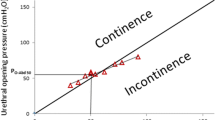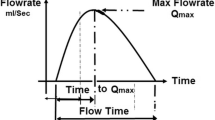Abstract
Introduction and hypothesis
The urethral closure mechanism in women is incompletely understood. Measuring closure function in a collapsed urethral tube without distending the tube and changing its natural shape is impossible with conventional methods. Over the last decade, studies with urethral pressure reflectometry (UPR), a method that measures pressure and the corresponding cross-sectional area along the entire length of the urethra continuously by means of acoustic reflectometry, have been performed. The studies have mainly been performed on patients with stress urinary incontinence (SUI).
Methods
Our aim was to provide an overview of the studies conducted with UPR, establishing whether the method may be used in clinical practice. We reviewed all literature published on UPR.
Results
Urethral pressure reflectometry is easily performed with limited bother for the patient. The catheter consists of a 45-cm-long PVC tube connected to a thin and highly flexible polyurethane bag, which is placed in the urethra. When inserted, the bag only occupies 0.4 mm2 of the urethra, respecting the natural shape and orientation of the urethra and, most importantly; respecting the laws of physics when measuring urethral pressure. UPR can discriminate patients with SUI from continent women and separate assessment of the sphincter function and support system is possible. Also, UPR has revealed statistically significant differences in urethral pressures after drug therapy for SUI.
Conclusions
We conclude that UPR has a place in clinical practice. The method has shown groundbreaking potential in the understanding of urethral dysfunction in SUI patients.







Similar content being viewed by others
References
Lose LG (1992) Simultaneous recording of pressure and cross-sectional area in the female urethra: a study of urethral closure function in healthy and stress incontinent women. Neurourol Urodyn 11:55–89. doi:10.1002/nau.1930110202
Susset JG, Shoukry I, Schlaeder G et al (1974) Stress incontinence and urethral obstruction in women: value of uroflowmetry and voiding urethrography. J Urol 111:504–513
Harris JH, Therkelsen EE, Zinner NR (1971) Electrical measurement of ureteral flow. In: Boyarsky S, Tanagho EA, Gottschalk CW, Zimskind PD (eds) Urodynamics. Academic Press, London, pp 465–472
Rask-Andersen H, Djurhuus JC (1976) Development of a probe for endoureteral investigation of peristalsis by flow velocity and cross section area measurement. Acta Chir Scand Suppl 472:59–65
Colstrup H, Mortensen SO, Kristensen JK (1983) A probe for measurements of related values of cross-sectional area and pressure in the resting female urethra. Urol Res 11:139–143
Lose G, Colstrup H, Saksager K, Kristensen JK (1986) New probe for measurement of related values of cross-sectional area and pressure in a biological tube. Med Biol Eng Comput 24:488–492
Gregersen H, Andersen MB (1991) Impedance measuring system for quantification of cross-sectional area in the gastrointestinal tract. Med Biol Eng Comput 29:108–110
Andersen IS, Gregersen H, Buntzen S et al (2004) New probe for the measurement of dynamic changes in the rectum. Neurogastroenterol Motil 16:99–105
Mortensen S, Djurhuus JC, Rask-Andersen H (1983) A system for measurements of micturition urethral cross-sectional areas and pressures. Med Biol Eng Comput 21:482–488
Colstrup H, Mortensen SO, Kristensen JK (1983) A new method for the investigation of the closure function of the resting female urethra. J Urol 130:507–511
Colstrup H (1984) Rigidity of the resting female urethra. II. Dynamic measurements. J Urol 132:82–86
Thind P (1995) The significance of smooth and striated muscles in the sphincter function of the urethra in healthy women. Neurourol Urodyn 14:585–618
Thind P, Lose G, Colstrup H (1991) How to measure urethral elastance in a simple way. Elastance: definition, determination and implications. Urol Res 19:241–244
Schäfer W (2001) Some biomechanical aspects of continence function. Scand J Urol Nephrol Suppl 35(207):44–60; discussion 106–125
Weber AM (2001) Is urethral pressure profilometry a useful diagnostic test for stress urinary incontinence? Obstet Gynecol Surv 56:720–735
Klarskov N, Lose G (2007) Urethral pressure reflectometry; a novel technique for simultaneous recording of pressure and cross-sectional area in the female urethra. Neurourol Urodyn 26:254–261. doi:10.1002/nau.20283
Lose G, Griffiths D, Hosker G et al (2002) Standardisation of urethral pressure measurement: report from the Standardisation Sub-Committee of the International Continence Society. Neurourol Urodyn 21:258–260
Saaby M-L, Klarskov N, Lose G (2013) Urethral pressure reflectometry during intra-abdominal pressure increase-an improved technique to characterize the urethral closure function in continent and stress urinary incontinent women. Neurourol Urodyn 32:1103–1108. doi:10.1002/nau.22368
Claerbout J (1968) Synthesis of a layered medium from its acoustic transmission response. Geophysics 33:264–269. doi:10.1190/1.1439927
Sondhi MM, Gopinath B (1971) Determination of vocal-tract shape from impulse response at the lips. J Acoust Soc Am 49:1867–1873
Fredberg JJ, Wohl ME, Glass GM, Dorkin HL (1980) Airway area by acoustic reflections measured at the mouth. J Appl Physiol 48:749–758
Klarskov N, Rasmussen SB, Lose G (2005) Pressure reflectometry: in vitro recordings with a new technique for simultaneous measurement of cross-sectional area and pressure in a collapsible tube. Physiol Meas 26:269–280. doi:10.1088/0967-3334/26/3/011
Klarskov N, Lose G (2007) Urethral pressure reflectometry vs urethral pressure profilometry in women: a comparative study of reproducibility and accuracy. BJU Int 100:351–356. doi:10.1111/j.1464-410X.2007.06922.x
Klarskov N, Saaby M-L, Lose G (2013) A faster urethral pressure reflectometry technique for evaluating the squeezing function. Scand J Urol 47:529–533. doi:10.3109/21681805.2013.776629
Klarskov N (2012) Urethral pressure reflectometry. A method for simultaneous measurements of pressure and cross-sectional area in the female urethra. Dan Med J 59:B4412
Klarskov N, Lose G (2008) Urethral pressure reflectometry and pressure profilometry in healthy volunteers and stress urinary incontinent women. Neurourol Urodyn 27:807–812. doi:10.1002/nau.20617
Chapple CR, Wein AJ, Artibani W et al (2005) A critical review of diagnostic criteria for evaluating patients with symptomatic stress urinary incontinence. BJU Int 95:327–334. doi:10.1111/j.1464-410X.2005.05293.x
DeLancey JOL (2010) Why do women have stress urinary incontinence? Neurourol Urodyn 29:S13–S17. doi:10.1002/nau.20888
Saaby M-L, Klarskov N, Lose G (2012) Urethral pressure reflectometry before and after tension-free vaginal tape. Neurourol Urodyn 31:1231–1235. doi:10.1002/nau.22239
Saaby M-L, Klarskov N, Lose G (2015) The impact of tension-free vaginal tape on the urethral closure function: mechanism of action. Neurourol Urodyn 34:50–54. doi:10.1002/nau.22513
Koelle D, Windisch J, Doerfler D et al (2006) Effect of tension-free vaginal tape operation on urethral closure function. Urology 67:524–528. doi:10.1016/j.urology.2005.09.063; discussion 528–529
Lo TS, Wang AC, Horng SG et al (2001) Ultrasonographic and urodynamic evaluation after tension free vagina tape procedure (TVT). Acta Obstet Gynecol Scand 80:65–70
Mutone N, Mastropietro M, Brizendine E, Hale D (2001) Effect of tension-free vaginal tape procedure on urodynamic continence indices. Obstet Gynecol 98:638–645
Abrams P, Cardozo L, Khoury S, Wein A (2012) Incontinence—5th International Consultation on Incontinence, Paris, 5 February
Saaby ML, Klarskov N, Lose G (2011) Simultaneous cystometry and urethral pressure reflectometry (UPR)—a new method. Neurourol Urodyn 30:787–1206
Klarskov N, Lose G (2008) Urethral injection therapy: what is the mechanism of action? Neurourol Urodyn 27:789–792. doi:10.1002/nau.20602
Bump RC, Benson JT, Yalcin I et al (2004) Biomechanical and electrophysiological effects of duloxetine in women with stress urinary incontinence. J Pelvic Med Surg 10 [Suppl 1]:37–38
Weil EH, Eerdmans PH, Dijkman GA et al (1998) Randomized double-blind placebo-controlled multicenter evaluation of efficacy and dose finding of midodrine hydrochloride in women with mild to moderate stress urinary incontinence: a phase II study. Int Urogynecol J Pelvic Floor Dysfunct 9:145–150
Klarskov N, Scholfield D, Soma K et al (2009) Measurement of urethral closure function in women with stress urinary incontinence. J Urol 181:2628–2633. doi:10.1016/j.juro.2009.01.114, discussion 2633
Klarskov N, Scholfield D, Darekar A et al (2010) Urethral pressure reflectometry is valuable for evaluating pharmacological therapies for stress urinary incontinence. Int Urogynecol J 21:166–168
Klarskov N, Darekar A, Scholfield D et al (2014) Effect of fesoterodine on urethral closure function in women with stress urinary incontinence assessed by urethral pressure reflectometry. Int Urogynecol J 25:755–760. doi:10.1007/s00192-013-2269-6
Klarskov N, Cerneus DP, Sawyer AW et al (2015) The effect of single oral doses of duloxetine, reboxetine and midodrine on the urethral pressure in healthy female subjects, using urethral pressure reflectometry in a placebo-controlled, randomized, crossover study. 40th Annual Meeting—Nice, France June 9–13, 2015: oral presentations. Int Urogynecol J 26(1 Suppl):1–21
Aagaard M, Klarskov N, Sønksen J et al (2012) Urethral pressure reflectometry; a novel technique for simultaneous recording of pressure and cross-sectional area: a study of feasibility in the prostatic urethra. BJU Int 110:1178–1183. doi:10.1111/j.1464-410X.2012.10997.x
Aagaard M, Klarskov N, Sønksen J et al (2014) Urethral pressure reflectometry, a novel technique for simultaneous recording of pressure and cross-sectional area in the prostatic urethra: testing in men without bothersome lower urinary tract symptoms. Scand J Urol 48:195–202. doi:10.3109/21681805.2013.831946
Mitchell PJ, Klarskov N, Hosker G et al (2010) Anal acoustic reflectometry: a new technique for assessing anal sphincter function. Colorectal Dis Off 12:692–697. doi:10.1111/j.1463-1318.2010.02194.x
Mitchell PJ, Klarskov N, Telford KJ et al (2011) Anal acoustic reflectometry: a new reproducible technique providing physiological assessment of anal sphincter function. Dis Colon Rectum 54:1122–1128. doi:10.1097/DCR.0b013e318223fbcb
Mitchell PJ, Klarskov N, Telford KJ et al (2012) Viscoelastic assessment of anal canal function using acoustic reflectometry: a clinically useful technique. Dis Colon Rectum 55:211–217. doi:10.1097/DCR.0b013e31823b2499
Hornung BR, Mitchell PJ, Carlson GL et al (2012) Comparative study of anal acoustic reflectometry and anal manometry in the assessment of faecal incontinence. Br J Surg 99:1718–1724. doi:10.1002/bjs.8943
Hornung BR, Carlson GL, Mitchell PJ et al (2014) Anal acoustic reflectometry predicts the outcome of percutaneous nerve evaluation for faecal incontinence. Br J Surg 101:1310–1316. doi:10.1002/bjs.9586
Latthe PM, Foon R, Toozs-Hobson P (2008) Prophylactic antibiotics in urodynamics: a systematic review of effectiveness and safety. Neurourol Urodyn 27:167–173. doi:10.1002/nau.20501
Acknowledgements
The authors would like to thank Laborie for the supply of catheters used for urethral pressure reflectometry.
Author information
Authors and Affiliations
Corresponding author
Ethics declarations
Conflicts of interest
Yasmine Khayyami and Gunnar Lose have received honoraria as investigators from Astellas. Niels Klarskov has received honoraria as a speaker/investigator and travel grants from Astellas.
Glossary
- Urethral pressure
-
The air pressure required to force the urethra open
- Cross-sectional area
-
The area of the opened lumen of the urethra
- High-pressure zone (HPZ)
-
The area with minimal urethral cross-sectional area at a given pressure
- Opening pressure
-
A measurement of the permanent closing forces that enable the urethra to remain closed
- Closing pressure
-
The pressure at which the urethra closes subsequent to dilation
- Elastance
-
Expresses the urethra’s resistance to deformation when exposed to an external force
- Hysteresis
-
Expresses the energy loss in the urethra during stretching
- Abdominal to urethral pressure impact ratio (APIR)
-
Expresses the effect of increasing abdominal pressure on urethral pressure
- PO-Abd 50
-
Opening pressure at an abdominal pressure of 50 cmH2O
- PO-Abd 100
-
Opening pressure at an abdominal pressure of 100 cmH2O
Rights and permissions
About this article
Cite this article
Khayyami, Y., Klarskov, N. & Lose, G. The promise of urethral pressure reflectometry: an update. Int Urogynecol J 27, 1449–1458 (2016). https://doi.org/10.1007/s00192-016-2964-1
Received:
Accepted:
Published:
Issue Date:
DOI: https://doi.org/10.1007/s00192-016-2964-1




